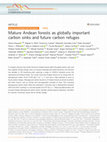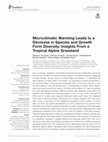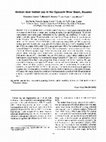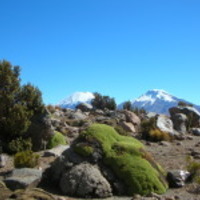Papers by Francisco Cuesta C.

Revista Pittieria, Mar 26, 2021
Los ecosistemas de los páramos enfrentan una creciente amenaza producto del cambio climático. La ... more Los ecosistemas de los páramos enfrentan una creciente amenaza producto del cambio climático. La red GLORIA-Andes constituye un esfuerzo a escala continental para documentar los cambios en la vegetación en cumbres a lo largo de la Cordillera de los Andes. En Venezuela se establecieron siete cumbres de monitoreo entre los 3800 m y los 4600 m de elevación en dos sitios de la Cordillera de Mérida: "Gavidia-Sierra Nevada" y "Culata-Piedras Blancas". En este trabajo presentamos una lista completa de la flora presente en las cumbres, describimos la riqueza taxonomómica, biogeográfica y de formas de vida observada y presentamos una clave para la identificación de todas las plantas vasculares. En los levantamientos durante la línea base (2012-2014) y el primer remuestreo (2017-2019), reportamos un total de 127 especies de plantas vasculares, incluyendo dos subespecies y dos híbridos, pertenecientes a 35 familias; siendo las mejores representadas Asteraceae con 36 (dos híbridos), Poaceae (20), Rosaceae (10) y Brassicaceae (6 y dos subespecies). Los géneros con mayor cantidad de especies fueron Lachemilla (7), Espeletia (6), Draba (5 especies y dos subespecies) y Calamagrostis (5). Con referencia a su origen fitogeográfico se observó una mayor riqueza de géneros Neotropicales (31,65%), Ampliamente Templados (31,65%) y Holárticos (12,66%). Aun así, observamos un alto nivel de endemismo a nivel específico, con 80 especies endémicas de los páramos de Sur América y 30 restringidas a Venezuela. Para la elaboración de la clave, se utilizó en lo posible rasgos vegetativos de fácil observación, minimizando el uso de caracteres reproductivos, de modo de facilitar la identificación en campo.
Informe de evaluación de Amazonía 2021
Human activities destroy biodiversity and disrupt the functioning of aquatic and terrestrial ecos... more Human activities destroy biodiversity and disrupt the functioning of aquatic and terrestrial ecosystems at different levels. This chapter provides sustainable approaches to address some of the biggest threats to the Amazon’s biodiversity and ecosystems, i.e., deforestation, damming of rivers, mining, hunting, illegal trade, drug, production and trafficking, illegal logging, overfishing, and infrastructure expansion. The role of restoration is addressed in chapters 28 and 29.

PLOS ONE
Aquatic insects in the order Trichoptera are extremely diverse in number of species and their tro... more Aquatic insects in the order Trichoptera are extremely diverse in number of species and their trophic roles. However, their distribution and diversity patterns are poorly known in the Neotropics, including the species restricted to tropical mountain ecosystems. Recent studies in tropical mountains have shown high levels of endemism of aquatic insects and changes in the composition of communities over short distances. Still, the incidence of environmental filters that explain such patterns has not been addressed quantitatively. Given the relevance of understanding Trichoptera spatial diversity patterns to prioritize conservation areas for freshwaters, as well as to obtain baseline information to predict changes in aquatic communities facing global environmental changes, we assessed the species distribution and assemblages of caddisflies along an elevational gradient from 600 to 3,600 m a.s.l. on the equatorial Andes. In this area, we had long-term continuous climate data with hourly ...
Vegetation baseline data from 13 GLORIA-Andes long-term monitoring sites. The file contains: (1) ... more Vegetation baseline data from 13 GLORIA-Andes long-term monitoring sites. The file contains: (1) a matrix of the average cover of each vascular plant species, averaged over the sixteen 1x1 m quadrats in each of the 50 summits, (2) environmental matrix that containes fine and broad-scale habitat variables for each summit, (3) A species richness matrix that contains the total number of species found in the sixteen quadrats established in each summit, and (4) a species richness matrix at the site scal
Plant species cover (%) by aspect (N, S, E and W) and summit (1-ALZ, 2-HUA, 3-SIN, 4-ISA) at 1m2 ... more Plant species cover (%) by aspect (N, S, E and W) and summit (1-ALZ, 2-HUA, 3-SIN, 4-ISA) at 1m2 plot scale (mean of four plots by aspect). Total of 16 plot by summit. For base line (2006-08), re-survey 1 (2012) and resurvey 2 (2017), following GLORIA protocol, in Cumbres Calchaquies, Tucuman, Argentina

Nature Communications, 2021
It is largely unknown how South America’s Andean forests affect the global carbon cycle, and thus... more It is largely unknown how South America’s Andean forests affect the global carbon cycle, and thus regulate climate change. Here, we measure aboveground carbon dynamics over the past two decades in 119 monitoring plots spanning a range of >3000 m elevation across the subtropical and tropical Andes. Our results show that Andean forests act as strong sinks for aboveground carbon (0.67 ± 0.08 Mg C ha−1 y−1) and have a high potential to serve as future carbon refuges. Aboveground carbon dynamics of Andean forests are driven by abiotic and biotic factors, such as climate and size-dependent mortality of trees. The increasing aboveground carbon stocks offset the estimated C emissions due to deforestation between 2003 and 2014, resulting in a net total uptake of 0.027 Pg C y−1. Reducing deforestation will increase Andean aboveground carbon stocks, facilitate upward species migrations, and allow for recovery of biomass losses due to climate change.

Frontiers in Ecology and Evolution, 2021
Analyzing plant phenology and plant–animal interaction networks can provide sensitive mechanistic... more Analyzing plant phenology and plant–animal interaction networks can provide sensitive mechanistic indicators to understand the response of alpine plant communities to climate change. However, monitoring data to analyze these processes is scarce in alpine ecosystems, particularly in the highland tropics. The Andean páramos constitute the coldest biodiversity hotspot on Earth, and their species and ecosystems are among the most exposed and vulnerable to the effects of climate change. Here, we analyze for the first time baseline data for monitoring plant phenological dynamics and plant–pollinator networks along an elevation gradient between 4,200 and 4,600 m asl in three mountain summits of the Venezuelan Andes, which are part of the GLORIA monitoring network. We estimated the presence and density of plants with flowers in all the summits and in permanent plots, every month for 1 year. Additionally, we identified pollinators. We calculated a phenological overlap index between species. ...
Unparalleled levels of tropical forest restoration are required to counter decades of deforestati... more Unparalleled levels of tropical forest restoration are required to counter decades of deforestation, minimise losses in biodiversity and aid in combating climate change. Restoration projects which disregard the temporal dimension (decades-centuries) risk restoring a degraded ecosystem, as our expectations of what is ‘normal’ diminish over generations. Actively incorporating ‘practical palaeo-reference ecosystems’ into restoration projects provide targets against which success can be measured.

Regional Environmental Change, 2021
The unique marine and terrestrial ecosystems of the Galapagos Islands are highly vulnerable to hu... more The unique marine and terrestrial ecosystems of the Galapagos Islands are highly vulnerable to human-based drivers of change, including the introduction of invasive species, unsustainable tourism, illegal fishing, overexploitation of ecosystem services, and climate change. These drivers can interact with climate-based drivers such as El Niño-Southern Oscillation (ENSO) at multiple temporal and spatial scales, exacerbating their negative impacts on already fragile ecosystems and the socioeconomic system of the Archipelago. In this review, we performed a literature review based on published literature from 1945 to 2020 and local and global climate databases to analyze drivers of change in the Galapagos. We developed and applied a spatial impact assessment model to identify high-ecological value areas with high sensitivity and exposure scores to environmental change drivers. We identified 13 priority HEVA that encompass ca. 23% (14,715 km2) of the Galapagos Archipelago, distributed in ...

Plant Ecology & Diversity, 2021
<b>Background</b>: Leaf functional traits (LFT) influence resource acquisition and ar... more <b>Background</b>: Leaf functional traits (LFT) influence resource acquisition and are important for understanding ecosystem processes. Climate and land use are key filters of community composition and LFT, however how the relative importance of these filters changes with elevation has been little studied in the Andes. <b>Aims</b>: To gain insight into the functional response of Andean forests to climate and disturbance in naturally regenerated forest stands. <b>Methods</b>: We measured leaf blade thickness (LBT), leaf area (LA), specific leaf area (SLA), and leaf dry matter content (LDMC) from 13 secondary forest communities, along a 3000-m elevation transect. We derived basal area-weighted mean (CWM) trait values to assess the effect of climate and disturbance on the functional structure of regenerating tree communities. <b>Results</b>: Community LFT progressively shifted along the elevation gradient driven by changes in temperature and successional stages towards communities with thicker leaves with low SLA. Reduction in LDMC with elevation suggested that both succulence and sclerophylly were important strategies in these forests. <b>Conclusions</b>: Our findings reinforce the validity of LFT as a powerful predictor to explore the ecological strategies of tree species in climate scenarios. Warmer conditions could result in a shift from slower to faster resource acquisition strategies at higher elevations.

Frontiers in Ecology and Evolution, 2021
Due to warming, changes in microclimatic temperatures have shifted plant community structure and ... more Due to warming, changes in microclimatic temperatures have shifted plant community structure and dynamics in tundra and alpine regions. The directionality and magnitude of these changes are less known for tropical alpine ecosystems. To understand the likely trajectory of these shifts in the Andes, we conducted a warming experiment in the northern Andes—using open-top chambers (OTC). In this study, we ask (1) how do OTCs affect air and soil temperatures in microclimates of tropical alpine regions, year-round and during the dry season? (2) What are the effects of 7 years of warming on (a) the aboveground biomass (AGB) and (b) the plant taxonomic and growth form diversity? We installed five monitoring blocks in 2012 at ca. 4,200 m asl with 20 OTCs and 50 control plots randomly distributed within each block. We measured AGB, plant community diversity, and growth form diversity between 2014 and 2019. After 7 years of warming, we found significant increases in mean monthly (+0.24°C), dail...
Ecology and Evolution, 2019
Neotropical Biodiversity, 2017

As global climate change leads to warmer and dryer conditions in the central Andes, alpine plant ... more As global climate change leads to warmer and dryer conditions in the central Andes, alpine plant communities are forced to upward displacements following their climatic niche. Species range shifts are predicted to have major impacts on alpine communities by reshuffling species composition and abundances. Using a standardized protocol, we surveyed alpine plant communities in permanent plots on four high Andean summits in NW Argentina, which range from 4040 to 4740 m a.s.l. After a baseline survey in 2006-2008, we re-surveyed the same plots in 2012, and again in 2017. We found a significant decrease in plant cover, species richness and diversity across the elevation gradient in the three censuses, and a strongly decrease in soil temperature along the elevation gradient. We found a high plant community turnover (37-49%) among censuses, differentiating according to summits and aspects; major changes of community turnover were observed in the lowest summit (49%) and on the northern (47%)...

Ursus, 2003
One of the primary threats to Andean bear (Tremarctos ornatus) populations in Ecuador is conversi... more One of the primary threats to Andean bear (Tremarctos ornatus) populations in Ecuador is conversion of bear habitat to human uses, resulting in habitat loss and fragmentation. To develop science-based conservation plans, information on the suitability and distribution of Andean bear habitat is critically needed. We studied habitat use in the 721-km2 Oyacachi River Basin in the eastern Andes Mountains. We used bimonthly sign surveys along 1.6-km transects (n = 53) to determine habitat use. We recorded 549 and 202 locations of bear activity during 2000 and 2001, respectively; feeding signs were recorded most frequently (53.3%), followed by scats (19.6%), footprints (13.4%), hair (6.9%), tree marks (4.8%), trails (1.2%), and ground nests (0.8%). The combined total distance of surveyed transects for both years was 1,018 km with a corresponding sign encounter rate of 0.74/km. Use of the different vegetation types within the study area varied among the bimonthly sampling periods. Habitat ...

This chapter examines site-specific opportunities and approaches to restore terrestrial and aquat... more This chapter examines site-specific opportunities and approaches to restore terrestrial and aquatic systems, focusing on the local actions and benefits. Landscape and biome-wide considerations are addressed in Chapter 29. Chapter 28 in Brief: Restoration options for the Amazon Science Panel for the Amazon 2 Introduction Human-driven changes across Amazonian landscapes have affected biodiversity and associated ecological processes; this, in turn, has direct and indirect impacts on human well-being. Although much of the focus in the Amazon should be on preventing further forest loss and degradation (see Chapter 27), there is growing awareness of the importance of restorative actions aimed at reversing these processes. Restoration could be a fundamental component of nature-based solutions that address critical societal challenges1, including the protection and sustainable management of aquatic and terrestrial ecosystems, whether natural, human-made, or a combination of both2. Definitio...
PLOS ONE
Our knowledge about the structure and function of Andean forests at regional scales remains limit... more Our knowledge about the structure and function of Andean forests at regional scales remains limited. Current initiatives to study forests over continental or global scales still have important geographical gaps, particularly in regions such as the tropical and subtropical Andes. In this study, we assessed patterns of structure and tree species diversity along 4000 km of latitude and~4000 m of elevation range in Andean forests. We used the Andean Forest Network (Red de Bosques Andinos, https://redbosques.condesan.org/)








Uploads
Papers by Francisco Cuesta C.